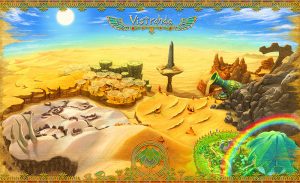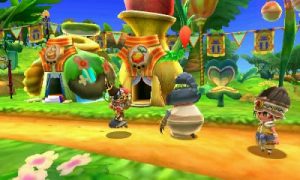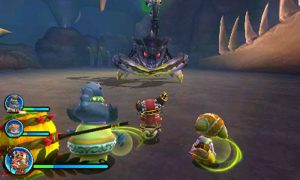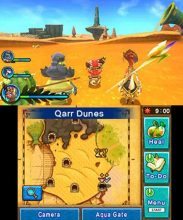Inspired By Zelda: Save Your New Town in Ever Oasis!
Posted on September 15 2021 by Joseph Berlinger

Welcome to another installment of Inspired By Zelda, the series of articles looking at games new and old that take inspiration and create a foundation based on some of the classic Zelda titles we know and love. Our aim is to spotlight the games that Zelda fans might enjoy adding to their catalog. Up today is Ever Oasis by developer Grezzo, available on the Nintendo 3DS.
Most Zelda fans will remember 2017 as the year that Breath of the Wild was released. That game recieved a lot of critical acclaim and boosted the sales of the Nintendo Switch. That success overshadowed some other titles that released in the same year. One such game was Ever Oasis, an action RPG and town simulator exclusive to the Nintendo 3DS. This Egyptian-themed adventure feels like a hybrid between the Legend of Zelda franchise and Animal Crossing. It was created by Grezzo, the same developers who put so much care into porting both Ocarina of Time and Majora’s Mask to the 3DS.
The Setting And The Story
 The country of Vistrada was once a lush and green land, but over time it became corrupted by an enigmatic and otherworldly enemy known only as Chaos. Chaos drained the life out of the world, leaving only ruins and a vast, unending desert. Few races survived the nightmare creatures that soon emerged, and those that did scrabble to eek out a meager living among the dunes. Depending upon whether you choose to play as a boy or a girl, you will play the part of Tethu/Thethi a Seedling. Seedlings are adorable little plant creatures that can only survive near sources of water. Unfortunately, the few remaining Oases are easy prey for the Nightmares. After tragedy strikes. Tethu/Tethi teams up with the last surviving water spirit Esna to build a new Oasis. To do so, they will attract residents, hunt for materials, defend the town from enemies, and delve into dungeons to secure magic artifacts that might ward off Chaos. This all plays out in a fashion that is very similar to a Zelda experience, but with some new tricks.
The country of Vistrada was once a lush and green land, but over time it became corrupted by an enigmatic and otherworldly enemy known only as Chaos. Chaos drained the life out of the world, leaving only ruins and a vast, unending desert. Few races survived the nightmare creatures that soon emerged, and those that did scrabble to eek out a meager living among the dunes. Depending upon whether you choose to play as a boy or a girl, you will play the part of Tethu/Thethi a Seedling. Seedlings are adorable little plant creatures that can only survive near sources of water. Unfortunately, the few remaining Oases are easy prey for the Nightmares. After tragedy strikes. Tethu/Tethi teams up with the last surviving water spirit Esna to build a new Oasis. To do so, they will attract residents, hunt for materials, defend the town from enemies, and delve into dungeons to secure magic artifacts that might ward off Chaos. This all plays out in a fashion that is very similar to a Zelda experience, but with some new tricks.
Managing The Town
One aspect that I wish more Zelda games would adopt is the town-building nature of Twilight Princess’s Kakariko Village and Breath of the Wild’s Terry Town. Both of these settlements start off empty, and gradually become vibrant communities thanks to Link’s efforts. In Ever Oasis, the town will do just that. Your Oasis will begins as as a dry, dusty roadstop with only one zone. As the story progresses and you attract more residents, the Oasis will octuple in size and become a lush-green paradise.
 Like the later Animal Crossing games, you serve as the chief of this community. It is the player’s responsibility to provide for the needs of the residents. Each vistor has the potential to become a resident, assuming that you can satisfy their requirements. These villagers run shops called Bloom Booths that sell items which in-turn can attract new visitors. Ever Oasis does a masterful job of making sure that each element of the game feeds into the others. The feedback loop means that the player is always profiting (even in small ways) from every completed task.
Like the later Animal Crossing games, you serve as the chief of this community. It is the player’s responsibility to provide for the needs of the residents. Each vistor has the potential to become a resident, assuming that you can satisfy their requirements. These villagers run shops called Bloom Booths that sell items which in-turn can attract new visitors. Ever Oasis does a masterful job of making sure that each element of the game feeds into the others. The feedback loop means that the player is always profiting (even in small ways) from every completed task.
At first, you have to do everything yourself, meeting villagers, supplying them with materials, and growing the town’s food supply in a garden. But as the city grows, you can delegate! This is the true power of leadership in action. Get someone else to do things for you! Leveled Oases can send out hunting parties, assign gardeners, and deliver materials to shop keepers, all without direct player intervention. You grow from a struggling tribal chief into the manager of a potent industrial force.
Increase Your Roster to Power Up
What is the point of being a chief if you don’t have someone to lead? As a community focused game, the residents are the driving force behind the success of Ever Oasis’s gameplay. Each of the sixty possible additions to your village roster have their own personalities and needs. Fulfilling these needs grants benefits on both the individual and collective levels. With sixty possible residents, it may seem daunting to be able to acquire them all. Thankfully, gathering new villagers is not too difficult, as each new resident will give hints towards the next. In fact, it is not even necessary to max-out the town’s population to beat the game.
 There are two types of residents, Seedlings and Warriors. Warriors come from the other indigenous races, the scorpion-like Serka, rabbit inspired Lagora and the reptilian Drauk. Warriors cannot perform tasks around town outside of their specialization in combat. On the other hand, Seedlings are weaker but more versatile. Seedlings serve as laborers and merchants in the Oasis, but they can be pulled for their duties to partake in exploration and combat if the need arises.
There are two types of residents, Seedlings and Warriors. Warriors come from the other indigenous races, the scorpion-like Serka, rabbit inspired Lagora and the reptilian Drauk. Warriors cannot perform tasks around town outside of their specialization in combat. On the other hand, Seedlings are weaker but more versatile. Seedlings serve as laborers and merchants in the Oasis, but they can be pulled for their duties to partake in exploration and combat if the need arises.
Gaining new members of the Oasis benefits you in several ways. Each new resident increases the communal health-pool for out of town operations. Gaining certain numbers of residents can increase the size of the overall Oasis allowing for more shops and gardens. Members can level up and gain additional combat stats to perform better in the field. More importantly, each resident has their own special ability such as mining, digging, cutting through webs, healing, crushing boulders, paragliding, and creating illumination in dark areas. These abilities become critical for solving puzzles in the dungeon portions of the storyline.
Similar to the class members in Fire Emblem Three Houses, the residents all have their own unique personalities and morale. Seedlings in particular, have a lot to say as they each possess a mini-quest line. Completing these quests allows you to learn more about them as characters, and also increases their shop capacities and inventories. After all, more shops means more tax revenue for you the chief. So help out those villagers!
The Fight Stuff
 While in the Oasis, the camera is locked to a single front-on perspective similar to Animal Crossing. But as soon as you step out into Vistrada, the game changes into a fully three dimensional perspective like in Ocarina of Time or The Wind Waker. And just like those 3D Zelda games, you battle enemies by targeting them, then attacking with a variety of weapons. Tethu/Tethi and the residents start out fairly weak, but as they take up arms, they learn combo attacks that deal increased damage. Most of the fighting in Ever Oasis is very fluid, but I do wish there was some sort of blocking mechanic. The only way to avoid damage is to roll-dodge to the side. If I am not quick to break out of my attack combos, I will take revenge damage before I can dodge to safety.
While in the Oasis, the camera is locked to a single front-on perspective similar to Animal Crossing. But as soon as you step out into Vistrada, the game changes into a fully three dimensional perspective like in Ocarina of Time or The Wind Waker. And just like those 3D Zelda games, you battle enemies by targeting them, then attacking with a variety of weapons. Tethu/Tethi and the residents start out fairly weak, but as they take up arms, they learn combo attacks that deal increased damage. Most of the fighting in Ever Oasis is very fluid, but I do wish there was some sort of blocking mechanic. The only way to avoid damage is to roll-dodge to the side. If I am not quick to break out of my attack combos, I will take revenge damage before I can dodge to safety.
Tethu/Tethi is not alone in exploring, hunting, and fighting. At any time, you can have up to two residents join you as companions. These characters are fully controllable and you can switch between them at will. Each member of the Oasis has their own special abilities, combat styles, and bonus effect that is unleashed after filling a power meter. Warriors are the strongest fighters and have the highest statistics; however, each race of warrior carries a specific weapon. Seedlings can be equipped with multiple weapon types and are the only fighters to have ranged attacks. To add some rock-paper-scissor mechanics to the combat, these weapons are more or less effective against the different enemy types: Beasts, Reptiles, Bugs, Flying, Arcane, and Chaos. This system encourages the player to carefully choose which residents will join Tethu/Tethi in battle.
Dangerous Desert Dungeons
 Like in the traditional Zelda games, Ever Oasis has dungeons with keys, puzzles, and bosses. Tethu/Tethi delve into these depths to secure important magic items that will extend their home’s protection against the encroaching Chaos. Each dungeon boss is unique and a couple can be challenging to beat. By far, I found dungeon three to be the most challenging in its platforming and plant-based hazards. There is only one glaring problem, a lack of visual variety in the dungeons. Every main-story dungeon and mini-dungeon takes place in elemental themed caves. There are only so many ways to make rock walls and dirt floors visually distinct. This is too bad, as the outdoor areas are bright and lively. Bland interiors in the underground is probably my largest gripe with the game.
Like in the traditional Zelda games, Ever Oasis has dungeons with keys, puzzles, and bosses. Tethu/Tethi delve into these depths to secure important magic items that will extend their home’s protection against the encroaching Chaos. Each dungeon boss is unique and a couple can be challenging to beat. By far, I found dungeon three to be the most challenging in its platforming and plant-based hazards. There is only one glaring problem, a lack of visual variety in the dungeons. Every main-story dungeon and mini-dungeon takes place in elemental themed caves. There are only so many ways to make rock walls and dirt floors visually distinct. This is too bad, as the outdoor areas are bright and lively. Bland interiors in the underground is probably my largest gripe with the game.
Ever Oasis has an interesting feature that is unlocked partway through the story. To gain experience, loot, and rare items Tethu/Tethi can enter the Labyrinth. This procedurally generated dungeon is entirely optional, but it can reap rewards if you dare to tread its halls. The unique aspect of this location is the fact that the Labyrinth can be visited as many times as you want. Each time the dungeon will have a different combination preset rooms. These rooms are populated by enemies whose strength and type is determined by what tiles you insert on the dungeon door. Monster tiles are picked up throughout the story, and can be brought back at any time to gain more loot in the Labyrinth.
The Labyrinth also has an appealing stone-carved design and catchy theme song. This makes coming back here time and again more appealing than the other dungeons. I wouldn’t stack Ever Oasis’s dungeons on par with the 3D Zelda dungeons, but they are close. My hat is off to Grezzo for coming up with enough unique ideas for the story locations, while staying true to their theme of towns above, dungeons below.
Artwork and UI
 For a 3DS game, Ever Oasis looks spectacular. Rather than push for photo realism, the game leans into the the console’s weak hardware to create a visually beautiful chibi design. The use of modern shaders takes the color pallette and boosts it to create a look that is even more vibrant than my favorite Zelda game The Wind Waker. Tethu/Tethi also bear a lot of similarity to Toon Link. They are all silent protagonists, waddle around as they move, and have a plethora of chibi expressions. The character designs are clean and display suprising attributes such as cloth physics. Most 3DS games didn’t manage to obtain such effects on the platform.
For a 3DS game, Ever Oasis looks spectacular. Rather than push for photo realism, the game leans into the the console’s weak hardware to create a visually beautiful chibi design. The use of modern shaders takes the color pallette and boosts it to create a look that is even more vibrant than my favorite Zelda game The Wind Waker. Tethu/Tethi also bear a lot of similarity to Toon Link. They are all silent protagonists, waddle around as they move, and have a plethora of chibi expressions. The character designs are clean and display suprising attributes such as cloth physics. Most 3DS games didn’t manage to obtain such effects on the platform.
Lighting is used to great effect to make the town’s colors pop. But outside is where the magic really happens. Most games make deserts a lonely and barren place (think of Twilight Princess’s Gerudo Desert for an example). That wouldn’t work for Ever Oasis, as the desert is the main setting. A great deal of effort was put into creating an atmosphere of interest and mystique amid the sands. This effect is most noticeable in Qarr Dunes, the first area outside of the Oasis. Not only is the Eqyptian-style music entrancing, but clever use of the skybox effects create a sense of scale. I love sitting out on the mesa at night, watching the sky will with stars. The moonlight reflects off the sands, creating a pale blue glow. The result is an enchanting effect that is pure visual delight for me.
The game’s user interface is quite clean and leaves little to be desired. Managing the bustling Oasis is made easy thanks to a streamlined menu system. My only problem is with the map system, which can be a little tricky to follow thanks to the abundance of underground highways beneath the multiple desert regions. Thankfully, there is a merciful fast travel system called the Aqua Gate that becomes a Godsend due to the multi-character nature of the dungeon puzzles.
Conclusion
Ever Oasis is a good game. It is one of the only 3DS games that can rival console titles for sheer content. The game’s artstyle is pleasing and easy on the eyes. Town management is quick and slick, with lots of charm and personality among the residents. The game does have a few problems. Dungeon design is bland and the combat could use some additional options to cut down on repetitiveness. Thankfully, these snags don’t weigh down the experience too much. On the whole, I give Ever Oasis a big thumbs up.
The game’s true problem is a lack of access. If you don’t have a 3DS, then there is no way to play Ever Oasis. But if you do have Nintendo’s last fully-handheld system, then the game can be bought from the 3DS eShop for about $39.99 USD. There is also a demo available if you want to give the Ever Oasis a try for free. The rumor mill is high that the 3DS eShop will be shutting down within the next couple years. If this is true, I would encourage you to give this game a chance while it is available.
Source: Nintendo
Joseph Berlinger is a writer for Zelda Dungeon. He enjoys history, video games, books and plays the mountain dulcimer.



